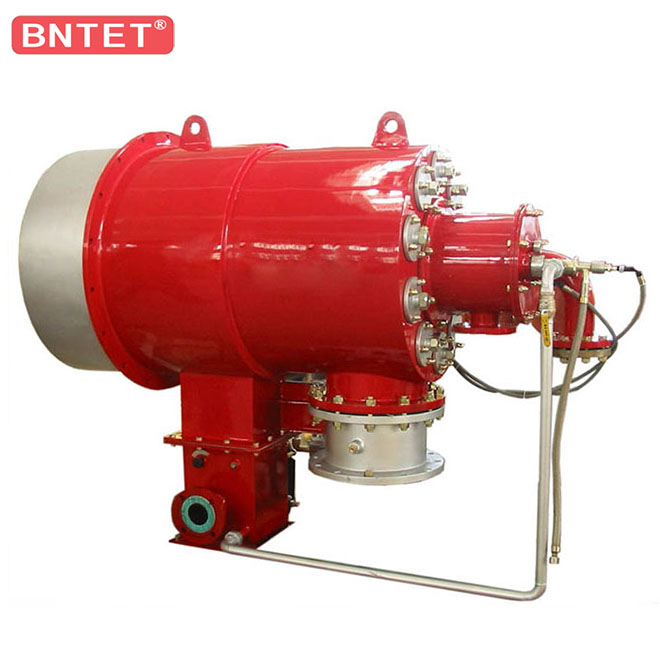In the development and design of gas burners, the characteristics of gas - inflammable, explosive and toxic, the primary problem of safety control.To introduce the following gas burner safety control requirements: according to the combustion characteristics of gas in the chamber of a stove or furnace control requirements for the security content mainly have preliminary blowing, automatic ignition and combustion condition monitoring, the protection of doesn't work, flame-out protection, gas pressure high and low limit of protection, insufficient air pressure protection, power protection, measures to prevent gas leakage accident, etc.

1. Pre-blowing
Before the burner ignition, there must be a period of pre-blowing, the furnace and flue in the residual air blown away or diluted.Since there is inevitably residual gas in the burner's working chamber, there will be the risk of explosion if the burner is ignited without pre-blowing.The residual gas must be blown clean or diluted to ensure that the gas concentration is not within the explosion limit.
The preblowing time is generally set to 15-60 seconds depending on the furnace structure and blowing volume
2. Automatic ignition
Electric spark ignition is suitable for gas burners to realize automatic control.High voltage ignition transformer can be used to generate arc ignition, and its output energy is required to be: voltage ≥ 3.5K V, current ≥15mA, and ignition time is generally 2 ~ 5 seconds.
3. Combustion status monitoring
The combustion state must be dynamically monitored. Once the flame detector detects the flameout signal, it must be fed back to the burner within a very short time. The burner will then enter the protection state and cut off the gas supply.
The flame detector should be able to sense the flame signal normally, neither sensitive nor dull.Because of sensitivity, if the combustion state fluctuates, it is easy to produce false action and slow, and the feedback flame signal lags behind, which is not conducive to safe operation.It is generally required that the response time from flameout to flame-detector flameout signal should not exceed 0.2 seconds.
4. Protection against fire
When the burner is ignited, the gas is fed into the burner and ignited.The ignition action should take place before the gas inlet, and the ignition temperature field should be formed first to facilitate the ignition and combustion.If the fire is not lit, the flame detector cannot detect the flame signal, and the burner enters the protective state.
The time from ignition to protection should be appropriate, neither too short nor too long.Too short, too late to form a stable flame;Too long, when the ignition does not cause a large amount of gas into the furnace.Generally, it is required that the burner judge the flame signal detected by the flame detector within 2-3 seconds after the gas is supplied. If there is no fire, the burner will enter the protective state, and if there is fire, the combustion will be maintained.
5. Extinguishing protection
During combustion, if the burner is accidentally shut off, the burner will be protected.Because the furnace is hot.Gas entry is prone to deflagration, so it is necessary to enter the protection state in a very short time and cut off the gas supply.The response time is required to be no more than 1 second from the occurrence of flame-out to the state of combustor entry protection.
6. Gas pressure high and low limit protection
The steady combustion of the gas burner has a certain range, and only the gas pressure is allowed to fluctuate within a certain range.The purpose of limiting the gas high and low pressure is to ensure the flame stability: no fire off, no flameout and no tempering, and limit the thermal power output of the burner to ensure the safe and economic operation of the equipment.When the gas pressure exceeds this range, the burner should be locked in operation.
Generally, gas pressure switches are used to sense pressure signals and output switching signals to control the corresponding work of burners.
7. Insufficient air pressure protection
Gas burners are designed with high thermal intensity, and their combustion mode is blast forced type.If the fan fault causes air interruption or air shortage, cut off the gas immediately, otherwise the furnace deflagration or temper to the fan will occur.Therefore, while improving the quality of the fan, the gas control must be interlinked with the air pressure. When the air pressure is insufficient, the gas supply should be cut off immediately.
Generally, the gas pressure switch is used to sense the air pressure signal and output the switching signal to control the corresponding work of the gas solenoid valve.
8. Power off protection
When the burner is suddenly cut off in the working process, it must cut off the gas supply immediately to protect the safety of equipment.Gas control solenoid valve must be normally closed, once power off, automatically shut off the gas supply.Solenoid valve closing response time ≤5s.
9. Measures to prevent gas leakage
Gas leakage includes two aspects: one refers to the gas leakage to the environment through the pipeline; the other refers to the gas leakage to the furnace through the solenoid valve spool end.
Environmental leakage may cause poisoning and explosion accidents at work sites, which must be taken seriously.First of all, ensure the pipeline sealing, regular pipeline leakage detection, if the pipeline leakage must be removed before continuing to use;Secondly, to avoid the concentration of gas that causes poisoning and explosion, good ventilation should be required at the working site: permanent ventilation holes and forced ventilation devices should be installed;In addition, fireworks and electrical parts shall not be explosion-proof in the work site.